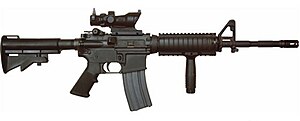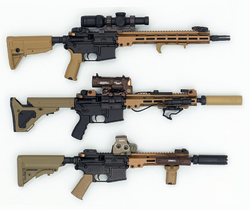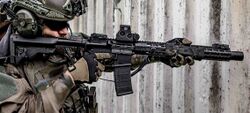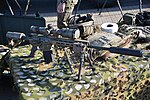BR-55 Assault Rifle
| BR-55 Assault Rifle | |
|---|---|
  Top to bottom BR-55A3 Assault Rifle, produced 1997 BR-55C, produced 1993 | |
| Place of origin | |
| Service history | |
| In service | 1963 - present |
| Used by | See Users |
| Production history | |
| Designed | 1958 |
| Manufacturer | Naxos Arsenal |
| Produced | 1961-present |
| Variants | See Variants |
| Specifications | |
| Weight | 3.40 kg (7.5 lb) |
| Length | 1 meter (39.5 in) |
| Barrel length | 0.5 meter (20 in) |
| Caliber | 5.56×45mm NS (Primary BR-55) (Variants vary) |
| Action | Gas-operated, rotating bolt (direct impingement) |
| Rate of fire | 700-950 rpm max sustained 50-60 rpm semi-automatic |
| Sights | Iron sights or various optics |
The BR-55 Assault Rifle is a Belfrasian-designed family of weapons designed to be used as the standard service weapon of the Belfrasian military. It replaced the BR-28 Battle Rifle as the military's primary service rifle after only five years of service, with military officials being unhappy with it's performance and the eager to keep up with rapidly accelerating technological advances.
The first rifles produced by Naxos arsenal for the BR-55 series fired the 5.56×45mm round in an easily removed 20-round magazine. The weapon's first usage was in the 1965-1970 Terror Bird Wars, a military action against an invasive tall-bird species that threatened to wipe out local farm-animal life and had previously managed to kill several farmers after their nests were disturbed in the late 1920s. Toward the end of the Terror Bird Wars in 1968 the older BR-28, which remained a popular weapon of choice for it's better stopping power against the large birds, was completely replaced as the primary service weapon for the Belfrasian forces.
Improvements to the weapon came in whole-model variant upgrades, the first being the BR-55A1 in 1973 which included corrective systems for faults as well as other improvements made from lessons learned during both the Terror Bird Wars and other foreign engagements conducted both by the Belfrasians and by foreign operators. Another upgrade, dubbed the BR-55A2, was released over a period of two years from 1981 to 1984 and was the first weapon to utilise the 1980-designed NASTAG (Naxos Standard) magazine for it's now standardised ammunition, which had been refitted into the older rifles. The variant showed significant improvements over it's predecessor and became a highly exported weapon since it's creation. In 1997 the BR-55A3 was first produced, featuring a revamped design once again that allowed for an incredibly high level of customisation and has become the military's primary usage of the BR-55 series.
In 1965 the military began to experiment with a shortened version of the BR-55 for usage with special forces and tank personnel. The first weapon designed to suit this requirement, coined the XR-55CAR, was produced two years later in 1967. In-field tests of the weapon proved that it worked on the existing BR-55's receiver system well, although accuracy as hindered by the shortened size and reduced ammo capacity. Improvements to the XR-55CAR, the XR-55CAR/A1 released in 1972, allowed it to carry a 30-round magazine and a standardised load-carrying attachment system meant it was easily carried by special forces personnel or tank crews while on deployment. The weapon was the first produced by Naxos to feature a fully retractable stock, a concept that later featured in the XR-55CAR's follow-on series.
Eventually in 1991 chief Naxos arsenals designer Marcellus Panaetius presented the completely redesigned XR-55CAR, calling it the 'BR-55C', for carbine. The BR-55C followed a lot of design influences learned from the XR-55CAR, but had a longer barrel of 14.5 inches as opposed to the 10-inch barrel of the XR-55CAR, of which half was a non-replaceable flash hider. The BR-55C featured a picatinny rail on the grip and receiver of the weapon as standard and had a collapsable rear iron sight, but static front ironsight that could be used to help align an attached scope.
While the BR-55C has a significantly reduced size and weight, it shares an 80% parts commonality with the BR-55 as well as an identical receiver system that utilises the same magazine types and ammunition, known as the Naxos Standard (or NS). Accuracy with the BR-55C is worse than that of the BR-55 which has a 5.5 inch longer barrel, although such inconsistencies only become apparent at ranges exceeding 180 meters (200 yards).
Design
The BR-55 Assault Rifle was designed as a lightweight magazine-fed assault rifle that had a reliable rotating bolt system that could reliably fire in fully automatic or semi-automatic firing modes on the fly in order to replace the BR-28 Battle Rifle, which while it would possess a larger cartridge size, had issues with it's grip posture and weight: When fully loaded with it's 20-round magazine, the BR-28 came in at 4.4 kg (9.70 lb). The BR-55A1 on the other hand, with a 30-round magazine weighed 3.6 kg (7.9 lb) The BR-55A2 weighs around 4.0 kg (8.8 lb) when loaded with it's 30-round magazine, the added weight being due to a thicker barrel profile that drastically reduces heat damage when under sustained fire and prevents damage when handled roughly - A complaint of earlier rifles was barrel distortion if heavy pressure as applied to one side.
Early models of the BR-55 featured a rifling inside the barrel that would cause the bullet to spin, stabilising it in flight and drastically improving accuracy at longer ranges. When the 1980's Naxos Standard (NS) came into effect the rifling was changed to accommodate the heavier, but more reliable, bullet design. The BR-55A2's thicker barrel modification only exists outside of the weapon's handguard, as inside the casing it does not require environmental protection.
The sights of the weapon were designed purposefully to present a similar image to users so that personnel when first equipped with the rifle over the previous BR-28 or BR-10 had the comfort of knowing that the sights of the weapon operated identically to those on their previous rifles, and during the early stages of it's service, when the BR-28 and BR-10 was still utilised in some areas, any changes of the weapon did not mean the operator had to get used to a new sight profile. The sights themselves utilise a low-light system which has the front sight post sport a weak light source provided by Tritium, a radioactive isotope of hydrogen. The front sight post are static on the weapon and could be adjusted through the use of a tool-operated dial to create the operators set point.
The rear sights of the weapon, initially an aperture within the weapon's distinctive carry handle and has two sights that could be flipped between that allows for sightings in the ranges of 0-300 meters or 300-400+ meters. The setting of both sights could be done through a dial on the side of the handle and, if needed, locked through a tiny switch just above the dial. When newer versions came into use with picatinny rails replacing the built-on carry handle, the front sight remained to usage with a back-up iron sight system which rested lower than the carry handle aperture but was meant for usage if the new attachable combat optics failed.
The BR-55 has always been considered a highly accurate rifle, with it's design permitting light recoil, high velocity and a flat trajectory of rounds which allow operators on target practice fields to reliably take headshots at around 300 meters. Tests of the Naxos Standard munitions indicated they had a significantly better flight profile which allowed a reliable hit picture out to 600 meters in range and staying within an 8 inch perimeter.
The BR-55 and it's variants were designed to be able to modified for usage with a high number of systems, although the BR-55A1 and A2 had to have their handguards replaced to fit them, making them semi-permanent attachments. The later BR-55A3 and the BR-55C, with their picatinny rails, were able to attach and unattach just modifications much easier through the use of screws and a small hex key. Such modifications possible include the under-barrel 40mm grenade-launchers, an under-barrel 12-gauge shotgun, or pistol grips for better control of the weapon.
The barrel of the weapon is designed to additionally be used in a variety of ways, with clip-attachment points allowing for the quick attachment of a bayonet, a hand-tightening support for a native bipod (since obsolete with picatinny), and GAIUS-type rifle grenades. The GAIUS rifle grenades are designed for usage with 5.56mm rifles, such as the BR-55, and slide over the barrel and propelled by the weapon firing a standard ball or tracer rounds out to ranges of around 30 meters and detonated by impact when the standoff rod is rapidly depressed in to the trigger. The rifle grenade delivered a 120 or 150 gram explosive package and, while designed for usage with breaching through doors, has found use in destroying non-hard cover or disabling a vehicle.
Carbine
Development of the BR-55C began in 1965 and was originally produced and utilised as the XR-55CAR, which featured the same stock and receiver of the BR-55 but with a significantly shorter handguard and barrel length. It was upgraded in 1972 to carry the new Naxos Standard (NS) magazines and featured a load-carrying attachment system that allowed it to utilise attachments mounted on the handguard. Two years later the design was improved with a collapsible stock.
In 1991 designer Marcellus Panaetius presented an advanced, purpose-built carbine that utilised the same gas ring, sights system and receiver of the BR-55 but a drastically improved handguard system. It's barrel is 5.5 inches shorter than the BR-55 at 14.5 inches, has a telescoping buttstock to reduce it's already compact size, weighing around 3.52 kg with a sight attachment and a 30-round magazine of 5.56×45mm NS Downsides of it's size means it has a lower muzzle velocity, resulting in a noticeable accuracy fall-off at ranges exceeding 180 meters (Although targets are still struck in a reliable group out to 210 meters by standard qualification shooters). The rifle also has a louder firing sound (called a report) and it's usage of the BR-55's gas system means that the stress placed on parts when firing is added, which also results in a tendency to overheat quicker than it's larger sibling.
A modification on it's receiver to the main BR-55 is it's feedramps which are extended into the upper receiver to alleviate feeding problems that occur from the increased pressure inside the shortened gas system. The BR-55C excels at close quarter combat, where it's compact size allows infantry to not worry about it's size when manoeuvring through rooms and hallways, and it's reduced size has since made it a favourite among troops in normal combat environments, meaning since it's inception it has seen a growing presence on the battlefield to a point where it may well overtake the BR-55 in usage by it's domestic armed forces.
In 2011 Naxos Arsenal announced that a special forces kit of the BR-55C would be released, featuring a 12.25 inch handguard fitted with modifiable rail attachment points to allow a user to modify the handguard to attach any kind of rail-compatible accessory possible through the usage of a six-point double-tighten system that utilises commonly found instruments that can be stowed into compartments on the handguard itself. The idea of the BR-55C/SFMOD was to allow special forces operators, who usually have a free hand to modify their weapons, a larger platform for modifications.
Bellator
The BR-55 Bellator is a modular, multi-role combat rifle developed by Naxos Arsenal for the armed forces of the Federation and allied nations. Designed to excel in a variety of combat scenarios, the Bellator combines cutting-edge engineering with battlefield versatility, making it a direct successor to all BR-55 models.
The Bellator is available in multiple configurations to suit different operational needs, including close-quarters combat (CQB), general infantry use, and designated marksman roles. The rifle features a lightweight, monolithic upper receiver made from advanced alloys for durability and weight reduction. Its free-floating Manticore Mk IV handguard supports a wide array of tactical attachments, while its adjustable gas system enhances reliability in harsh environments. The Bellator is capable of being chambered in a variety of rounds with the entire upper receiver capable of being changed out if needed.
Key features of the Bellator include an easy-to-change barrel system, allowing operators to switch between barrel lengths for mission-specific needs. It is available in 10.5-inch, 11.5-inch, 14.5-inch, and 18-inch barrel lengths, covering everything from compact urban combat to precision engagements. The rifle is also fully ambidextrous, with mirrored controls for magazine release, bolt catch, and fire selector, accommodating a wide range of users. An optics-ready Picatinny rail and compatibility with advanced accessories such as the Helios Reflex Optic and the Aquila Suppressor further enhance the rifle’s performance. A recent update to the system added the 20-inch system for overwatch and long-range engagements.
Bellator Silenti
The BR-55 Bellator Silenti is a specialized suppressed variant of the BR-55 Bellator rifle, designed by Naxos Arsenal to meet the needs of both the Myrmidon Special Operations Group (MSOG) and units requiring low-profile, noise-reduced weaponry. The Silenti incorporates an integrated suppressor directly into the barrel assembly, optimizing the weapon for stealth operations while maintaining the hallmark reliability and modularity of the Bellator platform.
The defining feature of the Silenti is its integrated suppressor system, seamlessly built into the barrel assembly. Unlike detachable suppressors, the integrated design reduces overall weight, improves balance, and eliminates the need for frequent adjustments during extended operations. The suppressor utilizes advanced sound-dampening baffle technology to minimize both the muzzle flash and sound signature, making the rifle highly effective in covert operations and low-light environments.
To ensure consistent performance across various ammunition types, including subsonic rounds, the Silenti features an enhanced adjustable gas system. This system allows operators to fine-tune the rifle for suppressed or unsuppressed firing conditions, maintaining reliability and reducing recoil. The integrated suppressor is optimized for 5.56mm rounds, with additional compatibility for subsonic variants designed specifically for the Silenti.
The Silenti retains the easy-to-change barrel system of the Bellator, offering barrel lengths of 10.5 inches (CQB) and 14.5 inches (standard suppressed configuration). The shorter barrel enhances mobility in confined environments, while the longer option ensures accuracy and range for mid-range engagements. Both configurations integrate the suppressor seamlessly, preserving the rifle’s modularity. While the shorter barrel comes with a reduced sound suppression profile, it still provides a better silenced profile and shorter length than the standard 10.5-inch configuration. The downside, Naxos has stated, is that each of the barrel length configurations is significantly more expensive than their standard Bellator configurations.
Variants
BR-55
- BR-55/S
- The BR-55/S is the first produced model of the weapon, with the /S missing from all except documentation separating the variants, with the /S standing for 'Standard', the Naxos titling to indicate the design was ready to go into production. It was in use for ten years until the conception of the BR-55A1, which replaced the weapon completely.
- BR-55A1
- The BR-55A1 improved over the original model in 1973 with the inclusion of a 'forward assist' that allowed the user to manually push the bolt forward if the return spring has or could not done so. The weapon features an improved 30-round magazine size that in 1980 was modified to allow for the new Naxos Standards to apply. It also features an improved magazine feed system that had a brushed edge to push any potential foreign objects in the magazine away from the chamber as it loaded a round.
- BR-55A2
- Sometimes known as the new-look upgrade, the A2 variant was introduced over a two-year period from 1981 to 1984 and became the first of the variants to utilise the NASTAG (Naxos Standard Magazine) which had been introduced in 1980, with the A1 retrofitted to fit it. Other additions made by the A2 were highly extensive, earning the 'new look' nickname it received. New rifling for the Naxos Standard upgrades was introduced, a thicker barrel in front of the front sight post helped avoid battle damage or warping from overheating, a new design handguard and other significant reliability upgrades were also made.
- BR-55A3
- Introduced in 1997, the BR-55A3 is a whole-body picatinny rail system that runs down the handguard and receiver system and can be equipped with the iconic carry handle as an accessory or instead utilise a dedicated optic device with a back-up iron-sight system installed instead. The highly modular variant has quickly become the most commonly used variant in the military and can be modified to accommodate a wide variety of tools, optics, or other items the operator wishes.
BR-55C
- XR-55CAR
- The XR-55CAR was designed by Naxos Arsenal in the early-1960's in order to provide special forces, vehicle crew and other such personnel with a compact weapon, sized like a submachine gun, but capable of rifle-levels of firepower at close quarters. The design was never adopted in a standardised fashion by the Belfrasian military, although it was purchased in relatively small batches for use by various specialised units. Throughout the years, different types of barrels of various profiles and three different lengths (10-inch, 11.5-inch and 14.5-inch were produced, attaching a variety of flashhiders. They were superceded by the BR-55C from the 1990's onwards.
- BR-55C
- The BR-55C was introduced in 1993 to replace the XR-55CAR, which was essentially the BR-55 with a shorter handguard and barrel, resulting in issues throughout it's service life that eventually saw it relegated to usage by reservist forces or special forces that meant it's small group of users in the field or lack of usage in the reserves meant it's issues were not prevalent and placed under too much scrutiny. The BR-55C improves upon these issues with purpose-designed parts while utilising the same gas firing system, iron sights, and receiver body of the larger BR-55 to maximise part compatibility. The BR-55C has since gone on to become a widely used weapon and is slowly replacing the larger, bulkier BR-55 for infantry personnel.
- BR-55CSFMOD
- Introduced in 2010, the SFMOD of the BR-55C's most obvious change is a 12.25 inch handguard with highly modifiable rail points that can be changed through the use of ones hands to hand-tighten attachments to it or a hex key that can be stored on the rail itself to tighten attachments onto the rail, such as grenade launchers, extra sights, laser markers
- BR-55CQBR
- Introduced in 2000, the CQBR is a version of the BR-55C which utilises a 10.5-inch short barrel. It is intended for users specialising in close quarters engagements in an enclosed environment, such as SWAT teams and naval boarding teams, as well as for vehicle crew and rear-area personnel as a self-defence weapon.
BR-55M
- BR-55M
- The BR-55M was designed in 2002 to act as a designated marksman rifle for usage with military units and special forces. Equipped with an 18 inch barrel with a free-floating that covered most of the barrel with a rail system on the top and bottom for the mounting of accessories. Rails on the side are limited if non-existent to allow ventilation holes for cooling the barrel down while firing. The receiver is the same as the BR-55 series but with a smooth, flat top-side to allow for the handguard rail system to extend to the buttstock of the weapon. The weapon comes as standard with a flip-up iron sight system that can be flattened down for the attachment of a sniper scope.
- BR-55MA1
- In 2003 Naxos introduced the BR-55MA1 as the 'larger-calibre' cousin of it's BR-55M. The A1 is chambered for the larger 7.62×51mm NS ammunition, meaning it has a slightly larger barrel and receiver system but has increased stopping power. It's barrel is 'flat-ended', allowing for a special made suppressor to slide over the entire barrel and lock with the handguard. The handguard itself has been upgraded with a newer rail system that includes front-end side rails
- BR-55MA2
- Naxos announced in 2010 that the A2 series of the BR-55M would be introduced with a replaced handguard featuring full-length raiil systems and a built-in front folding ironsight along with two 'lower-body' rail systems at barrel level for front-end attachments such as advanced suppressor systems or front-clip self-levelling tripods. The weapon also reintroduces a flash hider, removed in the A1 series, although this necessitates a new version of the weapon's silencer. It replaces the fixed, unmodifable buttstock with a modifiable buttstock to adjust the length for user preferences through the use of hand-tightened knobs.
- BR-55MA3
- The A3 variant of the BR-55M was introduced in 2020. It was intended to be a lighter, handier and more reliable weapon which can deliver accurate semi-automatic fire out to beyond 800m for infantry marksmen, snipers and spotters. It is fitted with an 17.5-inch, hammer-forged, chrome-lined barrel, an accessory attachment system using hollow slots in conjunction with traditional rails, double-stage trigger and adjustable stock.
Bellator
- BR-55 Bellator 10.5-inch
- (CQB Config), optimised for close-quarters combat and urban environments. Offers excellent maneuverability and compact size in exchange for a shorter range fall-off.
- BR-55 Bellator 11.5-inch
- (Short config), a short config of the standard model and is considered the '50-50' configuration for operators requiring a shorter length for CQB but range for a changing environment.
- BR-55 Bellator 14.5-inch
- (Standard config), a highly versatile option for infantry. Balances range, accuracy and portability.
- BR-55 Bellator 18-inch
- (Marksman config), designed for designated marksman roles. Features a drastically improved accuracy for mid- to long-range engagements.
- BR-55 Bellator 20-inch
- (Precision config), suited for overwatch and long-range engagements. Offers near-sniper performance in a lightweight platform.
- BR-55 Bellator Silenti 10.5-inch
- (CQB Config) natively suppressed variant of the 10.5-inch. Provides an excellent suppressed profile at a significantly higher cost.
- BR-55 Bellator Silenti 14.5-inch
- (Standard config) natively suppressed variant of the 14.5-inch. Provides an excellent suppresed profiel at a significantly higher cost.
BR-55X
- BR-55X 'Duklav's Special
- Introduced around 2020, the BR-55X was created via a collaborative program between Naxos Arsenal and the Private Military Company Duklav's Legion, which had a need to modernise the BR-55 rifles and carbines it possessed. The joint design team examined the most common commercial modifications available in the open market before finalising the model. The most significant change to the weapon's configuration is the use of a hexagonal handguard with hollow attachment slots in place of the older four-sided design with accessory rails, significantly reducing the weight of the mounting system. It also has a cold hammer-forged barrel for improved wear-resistance and accuracy. The weapon is produced in the rifle-length with a 20-inch barrel ('BR-55RX'), carbine-length with a 14.5-inch barrel ('BR-55CX') and the compact-length with a 10.5-inch barrel ('BR-55UX'). Naxos Arsenal has since released the BR-55X on the open market, capitalising on its 'Legion-approved' status for marketing purposes. Duklav's Legion receives partial royalty for every BR-55 weapon sold to third parties.










